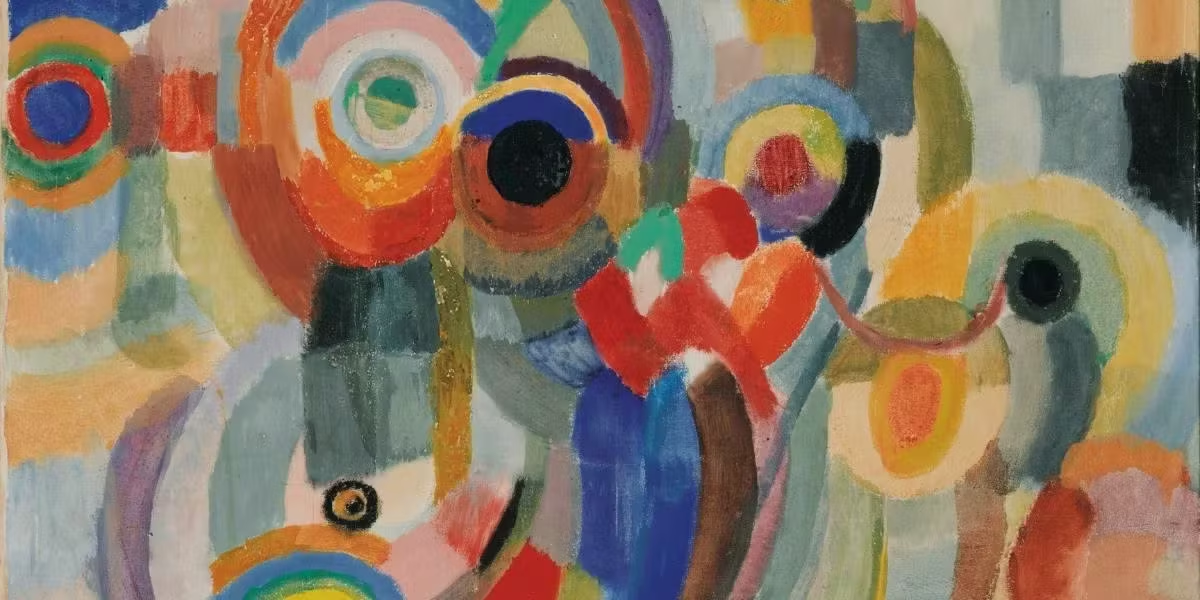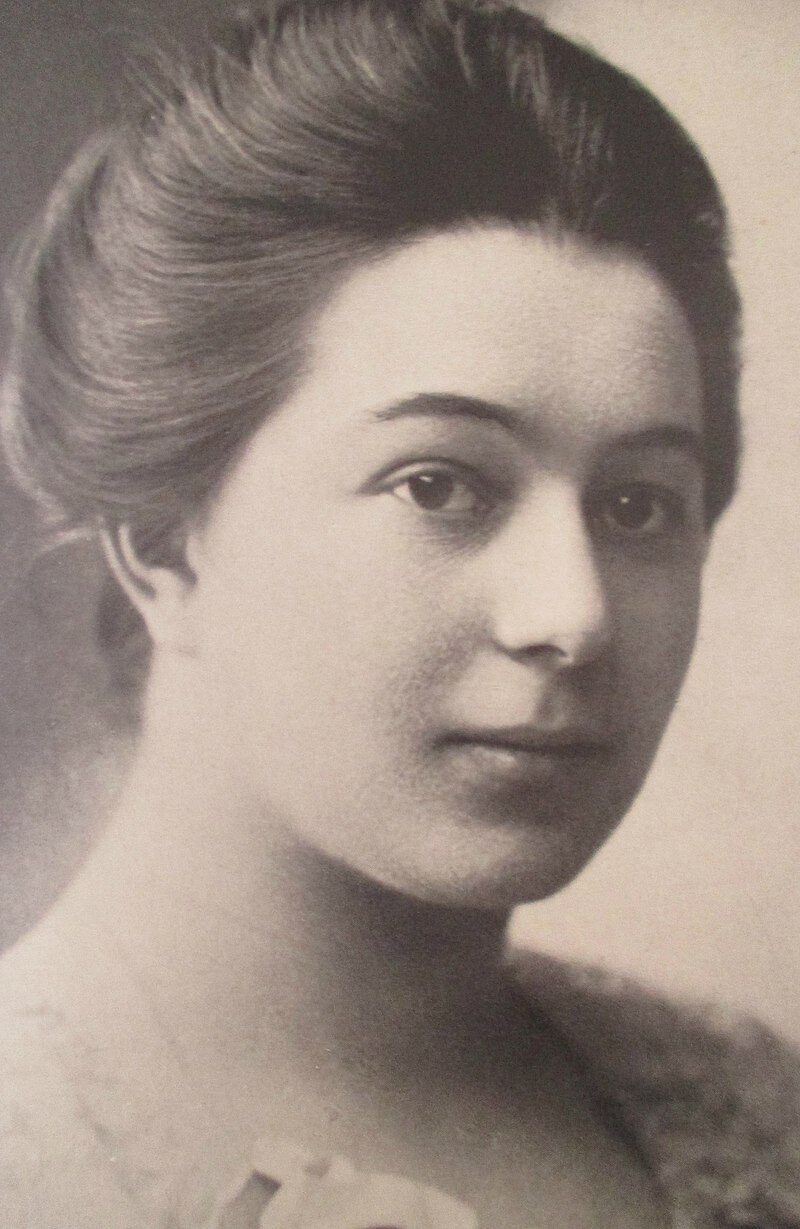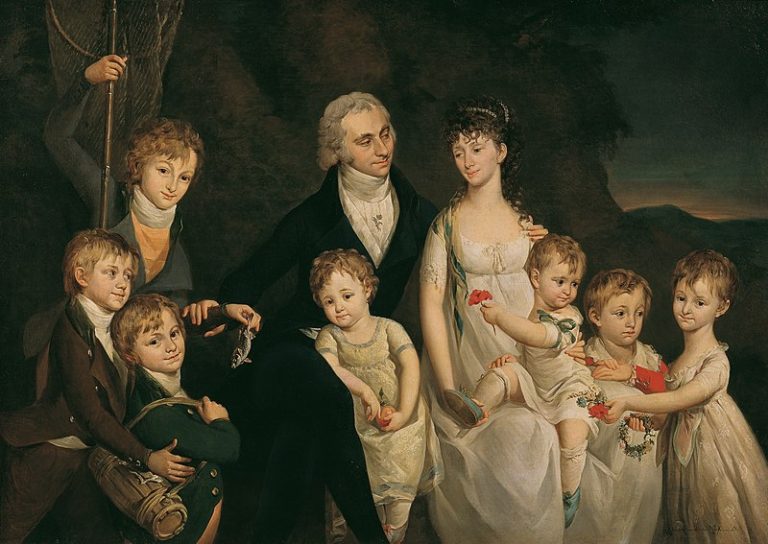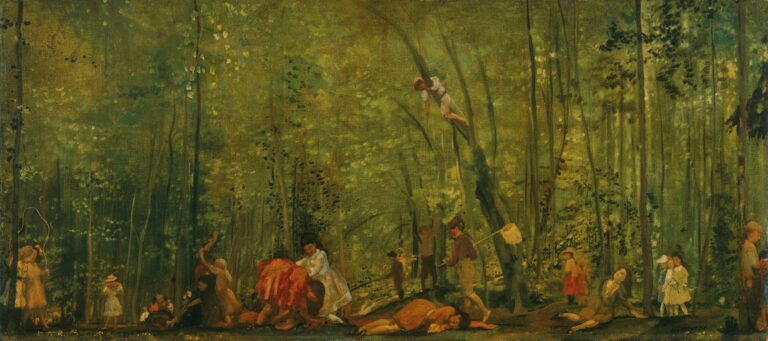Sonia Delaunay Painter: Pioneer of Abstract Art and Color Theory
Born: 14 November 1885, Hradyzk, or Odesa, Russian Empire
Death: 5 December 1979, Paris, France
Art Movement: Orphism, School of Paris
Nationality: Russian, French
Influenced By: Van Gogh, Gauguin, Henri Rousseau, Matisse, and Derain
Institution: Academy of Fine Arts, Karlsruhe and Académie de La Palette, Montparnasse
Sonia Delaunay Painter: Pioneer of Abstract Art and Color Theory
Early Life and Artistic Beginnings
Sonia Delaunay’s journey from her Ukrainian roots to becoming a pioneering artist in Paris shaped her unique artistic vision and approach to color and form.
Origins in Ukraine and St. Petersburg
Sonia Delaunay was born as Sarah Stern on November 14, 1885, in Odesa, Ukraine, which was then part of the Russian Empire. She was born into a Jewish family of modest means.
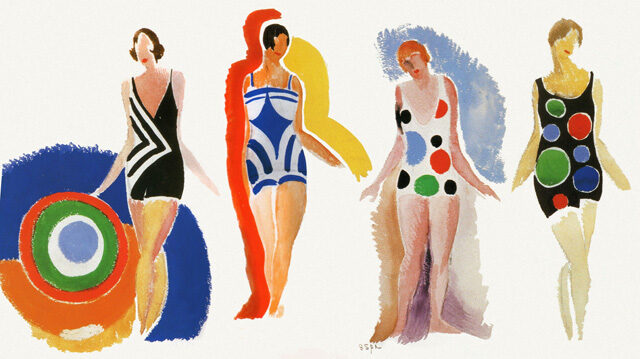
Swimsuits by Sonia Delaunay
At age five, she was adopted by her wealthy uncle Henri Terk and moved to St. Petersburg, where she became known as Sonia Terk.
In St. Petersburg, Sonia received a privileged education that included exposure to art, music, and European culture. Her aunt and uncle took her on frequent trips to European cultural centers, which broadened her artistic horizons.
Her formal art education began in 1903 when she studied at the Academy of Fine Arts in Karlsruhe, Germany.
By 1905, she moved to Paris to continue her artistic studies at the Académie de La Palette.
Move to Paris and Meeting Robert Delaunay
Paris transformed Sonia’s artistic vision. The city was the center of artistic innovation in the early 20th century. She immersed herself in the vibrant Parisian art scene and was influenced by Post-Impressionism and Fauvism.
In 1908, Sonia met French artist Robert Delaunay at a gallery exhibition. Their connection was immediate and profound, based on shared artistic ideas about color and abstraction.
They married in 1910 after Sonia’s brief marriage to art dealer Wilhelm Uhde ended.
The Delaunays’ artistic partnership became legendary. Together, they developed theories about color relationships and movement that would form the foundation of Orphism, an offshoot of Cubism characterized by bright colors and geometric forms.
Their son Charles was born in 1911, during the same period when Sonia was beginning to experiment with abstract compositions that would define her distinctive style.
Development of Orphism and Artistic Contributions

Étude Pour Portugal, 1937 by Sonia Delaunay
Sonia Delaunay emerged as a pivotal figure in the development of Orphism, transforming the art world with her innovative use of color and geometry. Her artistic vision extended beyond traditional canvas painting to encompass various design fields, creating a unified approach to art and life.
The Birth of Orphism and Collaborations
Orphism emerged in the early 20th century as an offshoot of Cubism, characterized by bright colors and geometric shapes. Sonia Delaunay, alongside her husband Robert, pioneered this movement through their exploration of “simultaneous contrast” – the visual effect created when complementary colors are placed side by side.
In 1913, Delaunay collaborated with poet Blaise Cendrars on “La Prose du Transsibérien,” a groundbreaking artist’s book. This 2-meter-long work combined Cendrars’ poetry with Delaunay’s abstract color compositions, embodying the Orphist principles of rhythm and movement.
Art dealer Wilhelm Uhde recognized her talent early, organizing her first exhibition.
Born as Sarah Stern in Ukraine, Delaunay brought a distinct sensibility to Parisian art circles, helping establish Orphism as a significant movement within the School of Paris.
Expansion into Textiles and Design
Delaunay’s artistic vision seamlessly expanded into applied arts during the 1920s. She established “Casa Sonia” in Madrid, where she created innovative fabric designs incorporating geometric abstraction principles from her paintings.
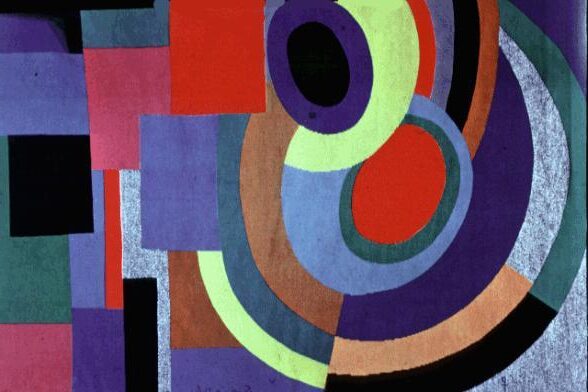
Icarus by Sonia Delaunay
Her textile work featured bold colors and dynamic patterns that revolutionized fabric design. Unlike conventional textiles of the era, Delaunay’s creations treated fabric as a true artistic medium rather than merely decorative material.
She designed costumes for Sergei Diaghilev’s Ballets Russes, including memorable work for “Cléopâtre.” These designs showcased her ability to translate Orphism’s principles into wearable art that enhanced performers’ movements.
Her wall coverings and interior designs extended her artistic vision into architectural spaces. This comprehensive approach to design reflected her belief that art should permeate everyday life.
Influence and Role in Modern Design
Delaunay’s revolutionary approach established her as both a respected fine artist and influential designer. Her work broke traditional boundaries between “high art” and applied design, influencing generations of creators across multiple disciplines.
Leading fashion designers like Hubert de Givenchy drew inspiration from her bold color combinations and geometric patterns. As a fashion designer herself, she created “simultaneous dresses” that embodied the principles of Orphism in wearable form.
Her textile designs incorporated modern manufacturing techniques while maintaining artistic integrity. This pragmatic approach made her work commercially viable while remaining conceptually innovative.
Delaunay’s legacy lives on in contemporary geometric abstraction and design. Her integration of art into daily life through textiles, fashion, and interiors demonstrated how modern artistic principles could transform everyday objects into expressions of beauty and innovation.
Legacy and Recognition
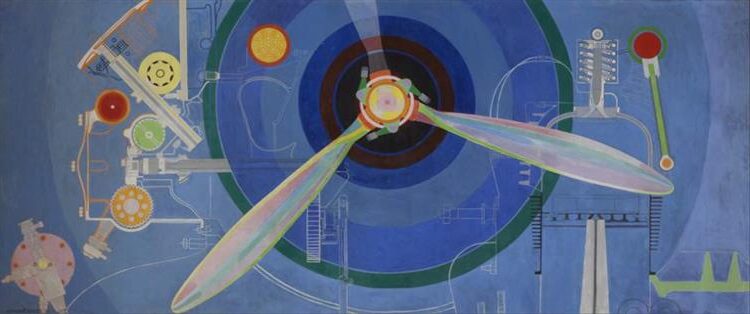
Hélice, 1937 by Sonia Delaunay
Sonia Delaunay’s influence on art, design, and fashion continues long after her death. Her pioneering work with color theory and abstract forms established her as one of the most important figures in 20th century modernism.
Major Exhibitions and Retrospectives
The Louvre honored Delaunay with a major exhibition in 1964, making her the first living female artist to receive this distinction. This landmark show cemented her place in art history and introduced her work to a wider audience.

Prismes électriques (1914) by Sonia Delaunay
In 1975, the Museum of Modern Art in New York held a comprehensive retrospective of her work, showcasing pieces from her entire career. This exhibition highlighted her contributions to abstract art and textile design.
The Skissernas Museum in Sweden hosted a notable exhibition of her work in the 1980s, focusing on her innovative use of geometric patterns and primary colors. Her pieces like “Electric Prisms” and “Portuguese Market” drew particular attention.
After her death, retrospectives continued to celebrate her legacy, with major shows in Paris, London, and Madrid bringing renewed attention to her artistic vision.
Awards and Honors Beyond Her Lifetime
Delaunay received the French Legion of Honor in 1975, recognizing her significant contributions to French culture and art. This prestigious award acknowledged her role in developing the avant-garde movement.
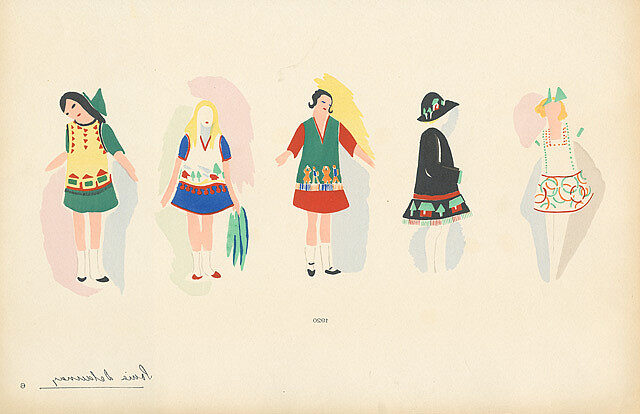
Fashion Illustration by Sonia Delaunay
Her designs for the 1937 Paris Exposition Internationale des Arts et Techniques earned her gold medals and established her reputation in commercial design. These awards highlighted her ability to merge art with everyday objects.
Modern museums now include her work in permanent collections, with her fabrics and paintings considered essential examples of modernism. Her innovative “Rhythme coloré” series is particularly valued by collectors and institutions.
Contemporary designers continue to cite Delaunay as an influence, especially her integration of art into daily life through textiles and fashion. Her bold use of color and geometric forms remains relevant in today’s design landscape.
Frequently Asked Questions
Sonia Delaunay pioneered vibrant color theory and abstract art through her groundbreaking work in Orphism. Her innovative approach merged fine art with practical design, creating a lasting impact across multiple creative disciplines.
What were the defining characteristics of Sonia Delaunay’s painting style?
Sonia Delaunay’s painting style featured bold geometric shapes and vibrant, contrasting colors. She developed a technique called “simultaneous contrast,” where colors appear more intense when placed next to their complements.
Her work explored rhythm and movement through circular forms and dynamic color relationships. This distinctive approach created visual vibrations and a sense of energy within her compositions.
Delaunay rejected representational art in favor of pure abstraction, allowing color and form to create meaning. Her paintings often featured overlapping discs and rectangular patterns that created a sense of depth and dimension.
How did Sonia Delaunay contribute to the Orphism art movement?
Delaunay was a key pioneer of Orphism alongside her husband Robert Delaunay. This movement emerged as an offshoot of Cubism, focusing on pure abstraction and vibrant color rather than the monochromatic palette common in early Cubist works.
She brought a unique perspective to Orphism by extending its principles beyond canvas paintings. Delaunay applied Orphist ideas to textiles, fashion, and interior design, making abstract art accessible in everyday life.
Her commitment to the movement’s core principles of rhythm, movement, and color theory helped establish Orphism as a significant influence on modern abstract art. Delaunay’s work demonstrated how abstract compositions could evoke musical qualities through visual harmony.
What impact did Sonia Delaunay have on the use of color in modern art?
Delaunay revolutionized color theory by developing the concept of “simultaneous contrast,” where colors intensify when placed next to their complements. This approach created dynamic visual experiences that seemed to vibrate with energy.
She rejected traditional color hierarchies, treating all hues as equally important elements in composition. This democratic use of color influenced generations of artists who followed her.
Delaunay’s experimental color juxtapositions created new visual sensations and emotional responses. Her bold approach to color relationships demonstrated how abstraction could evoke powerful feelings without representational elements.
Can you describe the evolution of Sonia Delaunay’s artistic career?
Born in Ukraine in 1885, Delaunay studied art in Germany before moving to Paris, where she became immersed in the avant-garde scene. Her early work showed influences of Post-Impressionism and Fauvism before she developed her abstract style.
The 1910s marked her shift toward complete abstraction and the development of Orphism. During this period, she created seminal works like “Simultaneous Contrasts” that established her reputation as an innovative colorist.
After World War I, Delaunay expanded her practice into commercial design, creating textiles, fashion, and interior designs. This period demonstrated her belief that art should be integrated into daily life rather than isolated in museums.
Which major art exhibitions have featured Sonia Delaunay’s work?
The Museum of Modern Art (MoMA) in New York has hosted several major exhibitions featuring Delaunay’s work, including retrospectives that highlight her contributions to abstract art. These exhibitions typically showcase both her paintings and design work.
The Tate Modern in London presented a comprehensive retrospective in 2015 that brought renewed attention to Delaunay’s multidisciplinary career. This exhibition emphasized her work across various media and her lasting influence on modern design.
The Centre Pompidou in Paris has frequently exhibited Delaunay’s work as part of its permanent collection and special exhibitions. As a French artist of Ukrainian birth, her work is particularly celebrated in these two countries.
How has Sonia Delaunay influenced contemporary artists and designers?
Contemporary fashion designers often cite Delaunay as an influence. They admire her use of geometric patterns and bold color combinations.
Her integration of art and fashion predicted today’s collaborations between fine artists and clothing brands.
Graphic designers have also adopted many principles from Delaunay’s color theory and compositions. They find her approach to creating visual rhythm through color relationships fundamental in design education.
Abstract painters continue to explore the territory Delaunay pioneered. They are interested in creating emotional responses through non-representational color relationships. Her work demonstrated that abstraction could be both intellectually rigorous and visually appealing.

